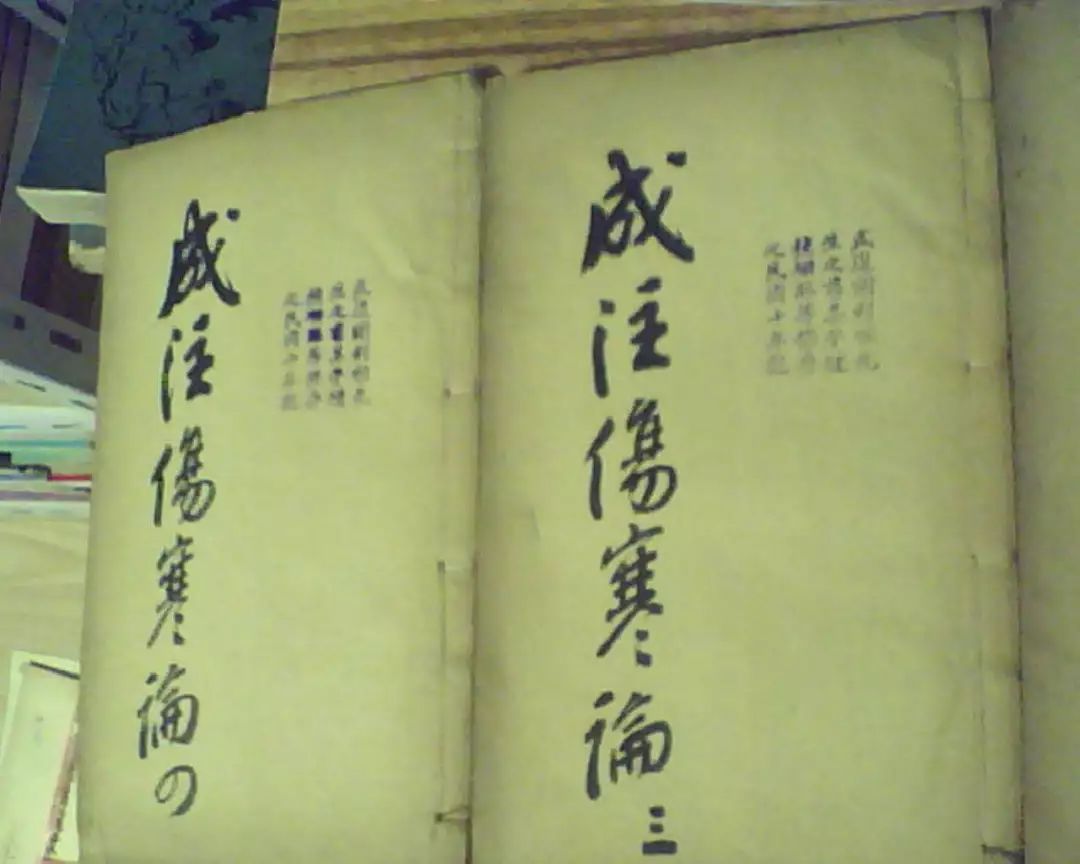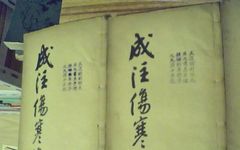Reading the preface of Zhang Zhongjing’s “Treatise on Cold Damage” states: “Diligently seek ancient teachings, widely gather various methods… thus the Treatise on Cold Damage and Miscellaneous Diseases is compiled into sixteen volumes.” Originally, the “Treatise on Cold Damage” was called “Treatise on Cold Damage and Miscellaneous Diseases,” and “Treatise on Cold Damage” is merely an abbreviation. Therefore, Wang Tao said: “Zhongjing’s book is one and the same, categorized as essentials, which began with Wang Shuhe.” Ming Dynasty’s Xu Rong also mentioned: “During the Song Dynasty, the Treatise on Cold Damage and the Essentials of Golden Coffer were divided into two books,” regardless of whether it was divided in Jin or Song, the “Treatise on Cold Damage” and “Miscellaneous Diseases” were separated, which is entirely a matter after Zhongjing’s time. Song’s Sun Qi and Lin Yi edited the “Essentials of Golden Coffer” and stated in the preface: “Wang Zhu was in the library and found three volumes of Zhongjing’s Essentials of Golden Coffer, the upper part distinguishes cold damage, the middle discusses miscellaneous diseases, and the lower part contains formulas and treatments for women,” indicating that during the Song Dynasty, there were still discoveries that included both cold damage and miscellaneous diseases, quite similar to the original text of Zhongjing’s “Treatise on Cold Damage and Miscellaneous Diseases.” The results of Sun Qi and others editing the “Essentials of Golden Coffer” concluded, “Due to the many sections in the cold damage text, it was separated from miscellaneous diseases, ultimately leading to dietary prohibitions, totaling twenty-five sections, excluding repetitions, combining two hundred sixty-two formulas, compiled into three volumes: upper, middle, and lower, still named the Essentials of Golden Coffer” (as seen in the preface of “Essentials of Golden Coffer” by Sun Qi et al.). This is generally how “Golden Coffer” is regarded as the origin of Zhongjing’s “Miscellaneous Diseases,” and it is not the original appearance of Zhongjing’s text.
The currently circulating versions of the “Treatise on Cold Damage” can be seen in two forms: one is the annotated version by Jin Cheng Wuyi, namely “Annotated Treatise on Cold Damage.” The other is the Song Dynasty’s Zhiping (1056) edition, which is the edited version by Gao Baoheng and others. Lu Yuanlei stated: “This version has been reprinted and is no longer the original, as cited in the ‘Ming Theory,’ the papers referenced differ from the main text. The ‘Compendium of Materia Medica’ mentions ginseng and bupleurum, yet in Zhang Zhongjing’s ‘Treatise on Cold Damage,’ it is referred to as ‘ren man zi hu.’ The current versions of the ‘Treatise on Cold Damage’ do not mention ‘jia’ or ‘zi,’ only the current version provides phonetic annotations, with ‘jia’ pronounced as ‘shen’ and ‘zi’ as ‘chai’ (note: both characters appear in the phonetic annotations of volume three), thus indicating that the current version retains many ancient characters. Li’s version is still the same, but now it has been completely altered by the unlearned” (as noted in the ‘Current Explanation of Cold Damage’). The Jin version, published during the Ming Jiajing period by Wang Jiming, is the best, while the original Song edition is no longer available. Currently, only the Ming Dynasty’s Zhao Kaimei’s reprint can be seen. Comparing the two, Cheng’s annotated version has already absorbed many known texts and has undergone further re-engraving, resulting in a greater output. Zhao Kaimei’s reprint is a copy of the Song edition, possibly closer to the Zhiping engraving’s appearance.
Zhao Kaimei’s reprint of the Song edition is still not easy to find in the market, thus many people are still unclear about the specific content of the Song edition of the “Treatise on Cold Damage.” Here is an introduction: the entire book is divided into ten volumes. The first volume: differentiating pulse methods, normal pulse methods. The second volume: examples of cold damage, differentiating spasmodic dampness pulse symptoms, differentiating Taiyang disease pulse symptoms and treatment above. The third volume: differentiating Taiyang disease pulse symptoms and treatment in the middle. The fourth volume: differentiating Taiyang disease pulse symptoms and treatment below. The fifth volume: differentiating Yangming disease pulse symptoms and treatment, differentiating Shaoyang disease pulse symptoms and treatment. The sixth volume: differentiating Taiyin disease pulse symptoms and treatment, differentiating Shaoyin disease pulse symptoms and treatment, differentiating Jueyin disease pulse symptoms and treatment. The seventh volume: differentiating cholera pulse symptoms and treatment, differentiating Yin-Yang imbalance disease pulse symptoms and treatment, differentiating conditions that should not induce sweating, differentiating conditions that can induce sweating. The eighth volume: differentiating post-sweating disease treatment, differentiating conditions that should not induce vomiting, differentiating conditions that can induce vomiting. The ninth volume: differentiating conditions that should not induce purging, differentiating conditions that can induce purging. The tenth volume: differentiating post-sweating, vomiting, and purging disease treatment. A total of twenty-two sections. The Cheng annotated version’s volume and sections are consistent with the reprint of the Song edition, only differing in many phrases, and the eighteen sections below differentiating Taiyang disease are combined. The general circulating version has removed the four sections before differentiating spasmodic dampness pulse symptoms and the eight sections after differentiating conditions that should not induce sweating, retaining only the ten sections from differentiating Taiyang disease pulse symptoms and treatment above to differentiating Yin-Yang imbalance disease pulse symptoms and treatment.
In addition, there is another version of the “Treatise on Cold Damage,” called “Golden Precious ‘Jade Beauty Classic,'” consisting of eight volumes, still edited by Song’s Gao Baoheng, Sun Qi, Lin Yi, etc. In their preface to the edited version, they stated: “The Golden Coffer ‘Jade Coffer Classic’ shares the same structure as the ‘Treatise on Cold Damage’ but has a different name, allowing for mutual review and serving as a complement to prevent future losses, demonstrating their deep concern for helping others. A detailed examination of the front and back reveals that it is a book compiled by Wang Shuhe. Since Zhongjing has a record of the Golden Coffer, it is named Golden Coffer Jade Coffer, signifying the meaning of treasure and preservation… Although its text and reasoning may differ from the ‘Treatise on Cold Damage,’ its significance is in accordance with the teachings of sages, and I dare not make arbitrary conclusions, thus both are preserved, totaling eight volumes, following the old titles, with a total of twenty-nine sections and one hundred fifteen formulas.” The circulating version of this book is even rarer; currently, only the reprint by He Zhuo from the late Kangxi period, based on the Song manuscript, is available. Whether it truly originated from Wang Shuhe remains uncertain, and there are many questions regarding its differences from the ‘Treatise on Cold Damage.’ The main differences are: it lacks Zhongjing’s preface; it does not include examples of cold damage; it has pulse differentiation but no normal pulse; the first volume has general examples of diagnosis and treatment; the seventh volume includes formula preparation; the section on spasmodic dampness is placed before pulse differentiation; the sections on Jueyin and other conditions are separated into two sections; and it adds ten sections on conditions that can or cannot be treated with warmth, fire, moxibustion, acupuncture, water, and conditions of heat disease with Yin-Yang intermingling and life and death symptoms (all ten sections are included in the ‘Pulse Classic’). The content of the general examples of diagnosis and treatment is generally similar to the ‘Thousand Gold’ treatment examples, symptoms, etc., and not only does it contain quotes from Zhang Zhongjing, indicating it is not Zhongjing’s work, but it also includes phrases like “earth, water, wind, and fire, harmonizing to form a person, when Qi is unbalanced, a hundred diseases arise, four spirits act, four hundred four diseases, all arise together,” which are phrases from Buddhist scriptures, suggesting its production era may be after the Wei and Jin dynasties.
The origins of the circulating versions of the “Treatise on Cold Damage” are roughly as follows: its ability to be transmitted through generations and revered by physicians throughout history is primarily due to its practical clinical effectiveness. Its essence lies in pulse differentiation and symptom formulas, all contained within the ten sections from differentiating Taiyang disease pulse symptoms and treatment to differentiating Yin-Yang imbalance disease pulse symptoms and treatment. Aside from this, the previous ten to twenty sections are mostly repetitive, with few being sayings from the ‘Pulse Classic,’ having little clinical significance, and even possibly not being clinical facts. Therefore, the ten sections on Taiyang disease and others are the most recited in the medical community, while the remaining sections are studied by only a very few, with most never having seen them in their lifetime.

Copyright Statement:
◇ Copyright belongs to the relevant rights holders. If there are any improper uses, please feel free to contact us.
◇ The article is collected from the internet, for clinical thought reference only. Non-TCM professionals should not attempt to use the herbs.
Currently, over 100,000 people have followed and joined us.















